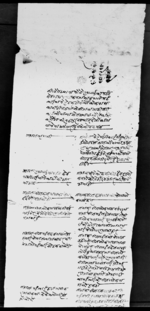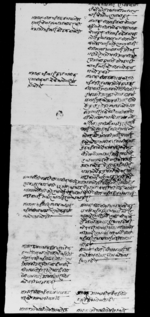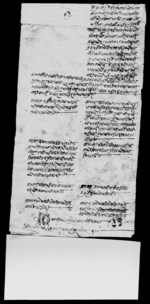A bakapatra supplied by Ṭīkārāma Nyaupānyā re Mahanta Chatranātha's abbatial succession in Rānagāũ (VS 1964)
ID: K_0469_0042
Edited and
translated by Christof Zotter
Created: 2018-06-26;
Last modified: 2019-01-22
For the metadata of the document, click here
The accompanying edition, translation/synopsis and/or commentary are available under the terms of the Creative Commons Attribution-ShareAlike 4.0 International License
Abstract
In this statement, made in front of Lieutenant Colonel Vīra Bahādūra Basynāt Chetrī of the Salyan dictrict office (gauḍā), the kharidāra Ṭīkārāma Nyaupānyā answers questions regarding the abbotship of Mahanta Chetranātha in Rānagāũ, Salyan.Diplomatic edition
[1r-part1]
श्री[seal]1दःलेकःवीर2वहादूरवस्न्या
3त्क्षत्री¯ ¯1जील्लैसल्ल्यानामौजेरानागाउकामहंत
2छेत्रनाथपरलोकभय़ाकाहुनाले•महं
3त्याईमामेरोहक्होमंन्यालोकनाथ•
4कावींतीपत्रमालेषीय़ाकासाछीषटी
5कारांन्यौपान्यालेसल्ल्याना•गौराकाले•
6कर्णैल•वीरवहादुरवस्न्यात्छेत्रीकासा
7मान्येमा•धर्मसम्झिवकेकोवकपत्र¯¯¯
8¯¯¯¯¯¯¯¯¯¯¯¯¯¯¯¯¯¯¯¯¯¯¯¯¯¯¯¯
[table1-part1]
| 1 | सव़ालमामुली¯¯¯¯¯¯¯१ | जवाफ्मेरोनाऊटीकारांवावुकोना ऊजोगदत्त•जातन्यौपान्याव्राह्म ण•घरसल्ल्यांसेजव़ाल्टाकुरामाछ पेसाषेतीगर्छुउमेरवर्ष५१कोभञाँ नीजहरुसंगलीनुदीनुझझैगडाके हीछैन¯¯¯¯¯¯¯ |
| सव़ाल•रानगाऊकामहंत•छेत्र नाथलाईचीनेकाछौकीहाल् काहाछन्¯¯¯¯¯¯¯ | जव़ाफ्चीनेकोछुजीवितछैनन्प्रलो कभय़ाकोये़ही६४साल्काजेष्ठमै न्हामाहो¯¯¯¯¯¯¯¯¯ | |
| सव़ाल•नीजछत्रनाथकाचेला छंछैनन्•भय़ाकोहो¯¯¯¯¯¯¯¯¯ | जवाफ्नीजछत्रनाथकाचेलालो कनाथछन्¯¯¯¯¯¯¯¯¯ | |
| सव़ालनीजलोकनाथकतीवर्ष काऊमेर•कैलेकेवेहोरा•संगचेलो भय़ाकाहुं¯¯¯¯¯¯¯¯¯ | जवाफ्नीजलोकनाथवर्ष१३का भय़ा•नीजमहंतछत्रनाथ•लेनी जलोकनाथलाई६।७वर्षभय़ो• दांचौघाेरास्थानमात्त्यागचु काईचेलोगराय़ाकाहुन्¯¯¯¯¯¯¯¯¯ | |
| सव़ाल•नीजमहंतछत्रनाथलेअ रुलाईचेलातुल्य़ाकाछन्की• भंय़ासोमहंत्याईकोहककस्कोहो | जवाफ्•नीजमहंतकाचेलाअ रुछैनन्•नीजलोकनाथ•मात्र •चेलाहुन्नीजमहंतछेत्रनाथ• सोर्गेहुन्यावषत्मा•नीजलो कनाथ•लाईपाषुरामासमाती• पीठीञामाधापलगाईय़ोमठ् गद्दीतेरोभय़ोभनी•अषतीय़ा रदीय़ाकाहुनाले•सोमठगद्दी कामहंत्याईकोनीजलोकना थकोहक्हो¯¯¯¯¯¯¯¯¯ |
[1r-part2]
[table]
| सव़ाल•महंत्याईहुंदा•सावीक् दरसावीक्मा•केकेक्सोगरिआ य़ाकोछ¯¯¯¯¯¯¯¯¯¯¯¯¯¯¯¯¯¯ | जवाफ्•नीजछत्रनाथकागुरु महंतहीरानाथसोर्ग्येहुदा•सा वीक्चलीआय़ावमोजींनीजही रानाथले•आफ्नाचेला•छत्रना थलाईमठ्कोअषतीय़ारिदीसो र्गे•हुदा•गुरुहीरानाथकोकाज कृय़ागरिसकेपछीसावीक्वमो जींसोसल्ल्यानागौड•काले• कर्णैलरणवीक्रंवाहादुरराणासँ गआईमेरागुरुमहंतहीरानाथले• सोमठ्को•अषतीय़ारिमलाई वक्सेकोछ•सावीक्दरसावीक्मा गुरुमहंतसोर्गेभय़ापछीचेला लेये़सगौडामाआईजाहेरगर्दागौ राकाभारदारले•गद्दीमावसाई आय़ाकोछमेरागुरुमहंतहीरा नाथसोर्गेहुनुभय़ोसोमठ्मा गद्दीवसाईपाऊन्याहुं•भनी•गौ डामावींतीपत्रदीदा•सावीक्चलीआय़ावमोजींनीजले•⟪टीकरांस्ही⟫⟪क•⟫⟪सही⟫रणवीक्रंरा णावहादुरवाटभनी•६२साल्काभाद्रमैन्हामा•१पट्टीसीपाहीवाजा गाजास्मेत्ली•सोरानागाऊमठ्माआफैगै•नीज•महंतछत्रनाथलाई गद्दीवसाईसर्कारमाजहेरगर्न्याकाहुन्¯¯¯¯¯¯¯¯¯¯¯¯¯¯¯ | |
| सव़ाल•महंतहीरानाथकागुरु• महंतषीमानाथका•परलोकहुदा• कसोभय़ाकोहो•¯¯¯¯¯¯¯¯¯¯¯¯¯¯¯ | जवाफ्•नीजषीमानाथपरलोक्हु दाभनी•महंतहीरानाथलेगौरा माजाहेरगरि•गौराकाचीफ्क र्णैललोकवाहादुरथापाछेत्री• ले१पट्टीसीपाहीवाजागाजास्मेत् लीआफैरानागाऊमाठ्मागैनीज महंतहीरानाथलाईगद्दीवसाय़ा काहुन्¯¯¯¯¯¯¯¯¯¯¯¯¯¯¯ | |
| सव़ालछत्रनाथमहंतपरलोक् हुन्यावषत्मा•सोमठ्कोकांतीमी लेगर्नुभनी•महंतछत्रनाथलेमला ईअषतीय़ारदीय़ाकाछंभनीदे वीनाथलेऊजुरगरेकाछंनीज देवीनाथलाईअषतीय़ारदीय़ा कोपनीथाहाछकी¯¯¯¯¯¯¯¯¯¯ | जवाफ्•नीजदेवीनाथलाईम ठकोअषतीय़ारदीय़ाकोमला ईथाहाछैन¯¯¯¯¯¯¯¯¯¯¯¯¯¯¯ | |
| सव़ालनीजछत्रनाथका मठ्कोआम्दानीकतीछ¯¯¯¯¯¯¯¯¯¯ | जव़ाफ्आम्दानीषर्चमहंतैवा टहुनेहुनालेथाहाछैन¯¯¯¯¯¯¯¯¯¯¯¯¯¯¯ |
[1r-part3]
[table]
| सव़ालय़ोमाथीलेषीय़ाकोदुरु स्तसाँचोहोकी¯¯¯¯¯¯¯¯¯¯ | जवाफ्•य़ोमाथीलेषीय़ाकोदु रुस्तसाँचोहोझुट्टालेषीदीय़ाको ठहर्योभनेऐनवमोजींवुझाऊला |
9ष•टीकारामजोतीसन्यौपान्या¯¯¯¯¯¯¯¯¯ \
10ईतीसम्वत्•१९६४साल्श्रावण१०गतेवार५शुभ्म्¯¯¯¯¯¯¯¯¯¯¯¯¯¯1सहीटीका
2रांसल्ल्यांसे
3जवाल्टाकुरा1दः
2ले•कसही
Translation
[1r-part1]
[seal]
[signature of] Da.1 L[ieutenant] C[olonel] Vīra Bahādūra Basynāt Kṣatrī - - -
Testimony (bakapatra) given, keeping the dharma in mind, in front of L[ieutenant] Colonel Vīra Bahādura Basynāta Chetrī of the Salyan dictrict office (gauḍā) by the kharidāraṬīkārāṃ Nyaupānyā, a witness mentioned (lekhīyāko) in the petition (bintīpatra) from Lokanātha which states "inasmuch as Chetranātha2 , the abbot (mahanta) of Rānāgāũ maujā, Salyan district (jillā), has passed away, the right to the abbotship is [now] mine."3
[table]
| Question: general [introduction] | Answer: My name [is] Ṭīkārāṃ; [my] father's name [is] Jogadatta. Caste (jāta): Nyaupānyā Brahman. [My] home is in Sejavāl Ṭākurā, Salyan. Profession: I do farming. Age: 51 years old. I have no business dealings4 [or] any dispute with the said people.5 | |
| Question: You know Mahanta Chetranātha of Rānāgāũ, or not? Where is [he] at present? | Answer: I know [him]. [He] is not alive [anymore]. [He] passed away in the month of Jyeṣṭha of this year, [VS 19]64. | |
| Question: Is there a disciple of the said late Mahanta Chetranātha, or not—[someone who] became one? | Answer: There is a disciple of the said Mahanta Chetranātha: Lokanātha. | |
| Question: How old is the said Lokanātha? When [and] in what manner did [he] become a disciple? | Answer: The said Lokanātha is 13 years old. The said Mahanta Chetranātha made the said Lokanātha [his] disciple 6 or 7 years ago at Ratannātha's site in DangCaugherā, 6 after [the latter] had conclusively left [his parents].7 | |
| Question: With regard to [the question] whether or not the said Mahanta Chetranātha made anyone else a disciple, who has the right to the abbotship? | Answer: There are no other disciples of the said mahanta. The said Lokanātha is the only disciple. When the said Mahanta Chetranātha was about to die, [he] seized Lokanātha's upper arm, slapped [his] back, said: "This monasterial throne is yours" [and] assigned [to him] authority; so the right to the abbotship is the said Lokanātha's. |
[1r-part2]
[table]
| Question: What all is traditionally done [and] how [is it done] in the customary practice when one accedes to the abbotship (mahantyāñī hundā)? | Answer: When the said Chetranātha's guru, Mahanta Hīrānatha, [was about to] pass away, the said Hīrānātha—according to the customary practice—assigned his own disciple Chetranātha authority over the maṭha, [and] after [the disciple] had performed the kājakṛyā8 of [his] late guru Hīrānātha, he came—according to the custom—to L[ieutenant] Colonel Ranavīkraṃ Bāhādura Rāṇā of the Salyan district office and submitted a petition to the gauḍā which states: "My guru Mahanta Hīrānātha granted me authority over the maṭha. In the customary practice, after a guru mahanta passes away, the disciple comes to this gauḍā and informs [it, and] the bhārādāra of the gauḍā installs [the appointee] on the throne. My guru Mahanta Hīrānātha passed away. May I be allowed to be installed on the throne in this maṭha." According to the customary practice, the said L[ieutenant] C[olonel] 9 Ranavīkraṃ Rāṇā Bāhādura took a group (paṭṭī) of soldiers [who came] singing and playing instruments (bājāgājā), went himself to the Rānāgāũ maṭha, installed the said Chetranātha on the throne [and] informed the government in the month of Bhādra of the [Vikrāma era] year [19]62. | |
| Question: What happened when Mahanta Hīrānātha's guru, Mahanta Khīmānātha, passed away? | Answer: When Mahanta Hīrānātha informed the district office that the said Khīmānātha had passed away, the head of the district office, Colonel Lokabāhādūra Thāpā Chetrī, took a group (paṭṭī) of soldiers [who came] singing and playing instruments (bājāgājā), went himself to the Rānāgāũ maṭha [and] installed the said Hīrānātha on the throne. | |
| Question: Devīnātha has submitted a complaint, saying: "When Chetranātha Mahanta was passing away, the said Chetranātha gave me the authority, saying, 'You do the work of [overseeing] the maṭha'."10 Do [you] also know or not whether [Chetranātha] gave authority to the said Devīnātha? | Answer: I do not know whether [he] gave authority over the maṭha to the said Devīnātha. | |
| Question: How much is the revenue of the said Mahanta Chetranātha's maṭha? | Answer: Since the revenue and the expenses are [controlled] by the mahanta, I do not know [how much]. |
[1r-part3]
[table]
| Question: Is what is written above the exact truth, or not? | Answer: What is written above is the exact truth. If it is proven that lies were written, I will pay the price according to the law. |
Kha[ridāra] Ṭīkārāma Jotīsa Nyaupānyā - - - 1
signature Ṭīkārāṃ, home [village]: Sejavāl Ṭākurā
signature Da.11 L[ieutenant] C[olonel]
Thursday, the 10th solar day (gate) of Śrāvaṇa in the [Vikrama] era year 1964 (1907 CE). Auspiciousness.
Commentary
This bakapatra was among the documents which were sent from Salyan to Kathmandu in support of a petition from Lokanātha to be recognized as successor to the throne (see K_0469_0033). For an elucidatory statement (kholuvā bayān) supplied by Ṭīkārāma in VS 1964, Bhādra 19 gate, see K_0469_0043.



